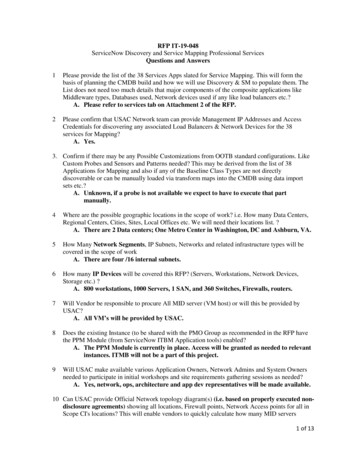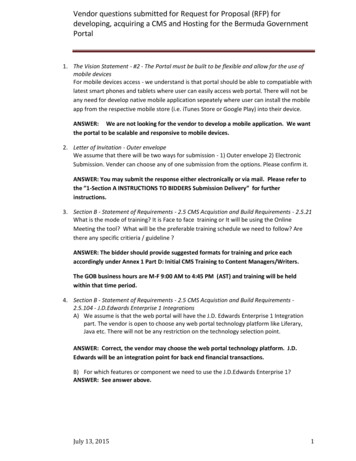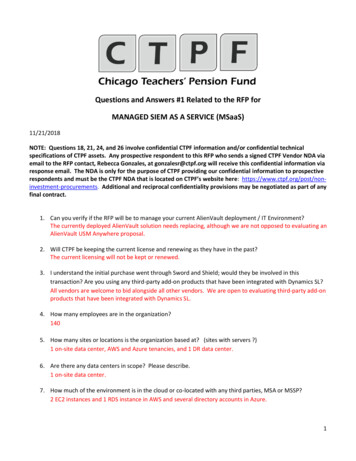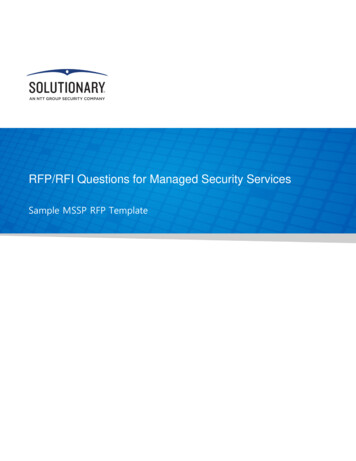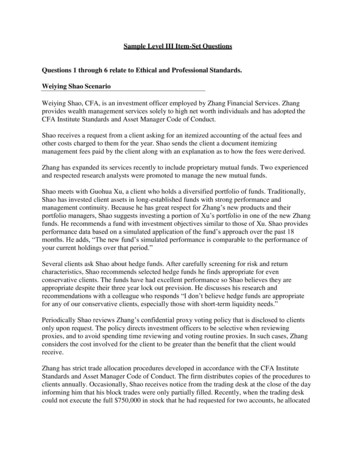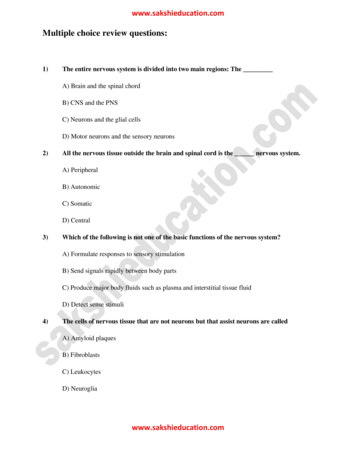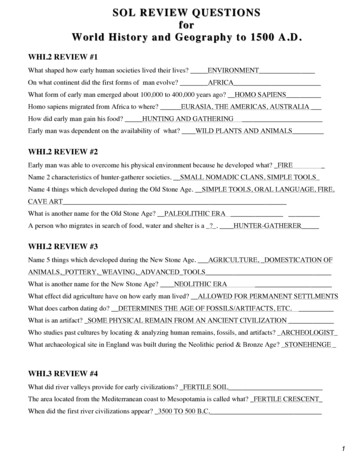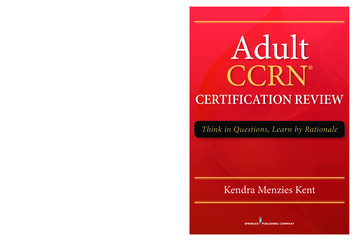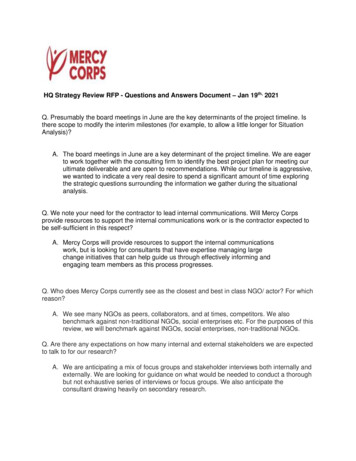
Transcription
HQ Strategy Review RFP - Questions and Answers Document – Jan 19th, 2021Q. Presumably the board meetings in June are the key determinants of the project timeline. Isthere scope to modify the interim milestones (for example, to allow a little longer for SituationAnalysis)?A. The board meetings in June are a key determinant of the project timeline. We are eagerto work together with the consulting firm to identify the best project plan for meeting ourultimate deliverable and are open to recommendations. While our timeline is aggressive,we wanted to indicate a very real desire to spend a significant amount of time exploringthe strategic questions surrounding the information we gather during the situationalanalysis.Q. We note your need for the contractor to lead internal communications. Will Mercy Corpsprovide resources to support the internal communications work or is the contractor expected tobe self-sufficient in this respect?A. Mercy Corps will provide resources to support the internal communicationswork, but is looking for consultants that have expertise managing largechange initiatives that can help guide us through effectively informing andengaging team members as this process progresses.Q. Who does Mercy Corps currently see as the closest and best in class NGO/ actor? For whichreason?A. We see many NGOs as peers, collaborators, and at times, competitors. We alsobenchmark against non-traditional NGOs, social enterprises etc. For the purposes of thisreview, we will benchmark against INGOs, social enterprises, non-traditional NGOs.Q. Are there any expectations on how many internal and external stakeholders we are expectedto talk to for our research?A. We are anticipating a mix of focus groups and stakeholder interviews both internally andexternally. We are looking for guidance on what would be needed to conduct a thoroughbut not exhaustive series of interviews or focus groups. We also anticipate theconsultant drawing heavily on secondary research.
Q. How many people are in the core internal strategy team the internal client team) for thisproject, in which functions? As this has implications on the organization of meetings andworkshops.Q. How many resources will be available from the "internal strategy team" to help support theSituational Analysis and Strategy Development phases of work? (Section III, Activities,Paragraph 4)A. The core internal client team consists of the following four individuals: The Vice President of Strategy and Learning is accountable for this strategyreview. The Senior Strategy and Learning Advisor is the primary project manager. The Senior Adviser for Strategic Program Partnerships has been seconded toour team for the purposes of this review and will support in analysis, synthesizingand communicating information. The Assistant Program Officer will support in all logistics and coordination.The internal client team is being guided by and reports to a Steering Committeewhich consists of a subsection of our executive team and is chaired by our CEO.Q. Which are the communication channels that MC currently uses and prefers within theorganization (beyond email, i.e. slack, intranet, Zoom, MS teams ?)A. Workplace (Facebook for business); a global newsletter; a combination of Slack andSkype - the internal client team will happily use either; Zoom and Google Hangouts forsynchronous meetings.Q. It hasn’t been mentioned in the RFP, but are you able to share the budget for this initial pieceof work?A. We do not share budgets.Q. Global Team Engagement / Internal Communications - Only related to the input given byMC staff and stakeholders and informing about the process, progress, results or related tooutputs of the developed strategy (socializing the result?)A. Also related to the outputs of the developed strategy - socializing the result andsupporting buy in as the process unfolds.Q. Are you open to firms partnering with other qualified firms to deliver this project?A. Yes. We would want to understand the skill sets and responsibilities of thefirms, what the combination offers that one of the firms alone would notoffer, and understand whether there has been a track record of collaborationthat enables the unique combination of firms to be the best candidate for ourpurposes.Q. On page 3, in the Mercy Corp Overview section, paragraph 5 - Most of the
metrics cited are activity metrics (# of people reached). We understand thechallenges you face in consolidated reporting of outcomes, so understand thepotential reasons behind this. Where is the best place for us to see a greaterpicture of how activity indicators and paired with the respective outcome data?A. The metrics cited were an assortment of indicators to demonstrate thebreadth and depth of our Impact, Influence, and Innovation. We believethat transformational change occurs through the combination of:programmatic impact; influencing change-makers at local and global levels;and a restlessness to innovate in search of better solutions.At Mercy Corps we pride ourselves on contextually-relevant market systemsapproaches. While each of our individual programs have outcome andimpact indicators, we do not consistently apply those across programs andvarying contexts. You can request access to a newly added documentwhich pulls together four impact briefs from flagship initiatives.Q. On page 7, in the Strategy Development section, first bullet - Why did you choose a 10-yearhorizon for your new vision?A. As a part of this strategy review process, we would like to expand our time horizon toexplore what doing so allows us to achieve in terms of greater clarity, focus, andsuccess metrics. This is a departure from how we have conducted strategy up to nowand will require acculturation.Historically, Mercy Corps’ approach to strategy has fallen into the emergent strategycategory. We have described strategy as a compass, not a map. The metaphor of the'Compass' signals our commitment to organizational agility and is a reflection of thehighly dynamic nature of the work we do and the places we do it. The StrategicFramework outlines and ties together our core tenets: our mission, Vision for Change,Core Strategies, and Guiding Principles. The Strategic Objective section outlinespriorities for the coming year, although many are designed as multi-year objectives withinterim metrics of success. Strategic Objectives provide targets and a means ofaccountability and transparency, and serve as the basis for reporting to Mercy Corps’leadership, global team and Board of Directors throughout the year.However, one of the dilemmas of this approach is that evolving objectives allow for theperception that there is no long term vision - Even though Compass objectives arealmost always multi-year and stated as such, there is a perception from some quartersand an accompanying narrative that Mercy Corps is not working towards a clear vision.We posit that by selecting a 10-year timeframe, we may be able to address this concernand with that, help the organization continue to evolve and transform.Q. On page 7, in the Global Team Engagement section - What communication channels andtactics does the organization already have in place to engage mid- and junior-level staff acrossthe organization? To what extent is your internal communications function available to execute
the communication needs of the project if provided direction on messaging, channels, andtactics?A. Communicating effectively with the whole organisation, including mid- and junior-levelstaff, is a priority for the Strategy Review. We are keen both to inform and to engagecolleagues across the organisation - so that it is not just a one-way communication fromHQ. Internal Communications will work with the consultant to identify the best ways to dothat. We already use channels including Workplace (Facebook for business); a globalnewsletter; a combination of Slack and Skype (the internal client team will happily useeither); Zoom and Google Hangouts for synchronous meetings. The consultant will beresponsible for designing the best ways to gather input from a wide range of MercyCorps staff, and until the consultant starts work we don’t know exactly what that will looklike. However, we expect mid- and junior-level staff to be able to share their thoughts ina range of ways, including through their line managers and in some cases as membersof Working Groups.On page 9, in the Cost Criteria section - Our typical pricing model is value-based pricing wherewe offer the client a firm fixed price for the scope of work. We do not bill our non-governmentclients based on hourly rates. Is this pricing approach acceptable or would it result in loss ofevaluation points in the Cost Criteria section?A. A fixed price proposal for the scope of work is an acceptable pricing approach and wouldnot result in loss of evaluation points strictly as a form of pricing versus time andmaterials.Q. What are the video conferencing capabilities across your footprint? What communicationchannels do you currently have available to you to engage all team members?A. We have consistently been using Google Hangouts and Zoom since the beginning ofCOVID-19. Most offices across the globe have been able to adequately adapt. Inaddition to Hangouts and Zoom, Mercy Corps uses Workplace, a global newsletter, andemails.Q. In light of COVID, what are your expectations for in-person consultation and workshops vs.digital ones?A. Due to COVID-19 we have limited all non-essential travel. Starting in March of 2020, allstrategic consultations have been conducted virtually. We anticipate that allconsultations and workshops for this strategy review will take place virtually.Q. The organization has clearly done strategic planning in the past. What about the processpreviously are you looking to improve by requesting an external partner?A. Mercy Corps is conducting a strategy review to ensure we maximise our impact, in acontext of rapid global change and upheaval. As we enter an exciting new phase underTjada’s leadership, this review will consider questions across a range of different areas,
including: our philosophy and purpose, our approaches and strategic priorities, ourstructure and our business model. We are overdue for a full fledged, ground up, reviewof our strategy. This will require a revised process and ultimately may result in a differenttype of product to our current Compass. The product and the process was cultivatedover years in direct response to the needs of the existing executive team. We areexcited to revisit both the process and the strategy product with the support of an outsideconsulting firm in order to bring in fresh perspectives, new skills, and uniqueapproaches.Q. What industry benchmark data do you already have access to?A. We have access to publicly available information about industry actors, such as totalrevenue, what is reported on 990s, etc.Q. Your most recent 990 does not seem to break down your sources of grant funding. Can youprovide us a sense of major donors?A. Institutional donors such as USAID, DFID (now the Foreign, CommonwealthDevelopment Office), ECHO, and others account for nearly 2/3rds of our revenues. Theother third is acquired through partnerships with Corporations, Foundations, andIndividual Donors.Q. Are the reviewers of the RFP responses accustomed to executive summary sections as partof proposals, particularly those of this type and page count?A. The selection committee is made up of a combination of individuals from a cross sectionof the organization. The page count for this proposal is short and we encourage you toutilize the space to the best of your ability.Q. Who is the visible sponsor of this effort in front of the organization?A. Tjada D’Oyen McKenna - Mercy Corps’ CEOQ. Who is the project manager of this effort and in what time zone are they based?A. The Senior Strategy and Learning Advisor is the project manager for this initiative,reporting to the Vice President of Strategy and Learning. Both are located in PortlandOregon, Pacific Standard Time.Q. What strategy frameworks, if any, have you been accustomed to using for strategydevelopment and execution? From your list of questions (page 4, in the Project Background
and Context section, paragraph 2, bullets 3 and 6), it seems apparent that SWOT is one ofthem.A. Planning takes place at different levels of the organization from individual projectsthrough to technical teams, and as the agency as a whole. Mercy Corps uses a suite ofstrategic planning tools, captured in a strategy toolkit, of which the SWOT is one ofthem. We are excited to experience new and creative ways of setting strategy with ourpartner as well as drawing on tried and tested frameworks.Q. One of the questions you articulate (page 4, in the Project Background and Context section,paragraph 2, bullet 8) is, “How do we build upon the substantive strategic thinking that we havealready done ” What strategic thinking have you already done? Might you provide us asummary of your most recent conclusions? Attached to this question, what plausible scenarioshave you discussed as a team or planned for, particularly beyond COVID?A. Please see the previously attached Global Program Vision and Strategy as oneimportant example. Significant work has been done on this over the past year and theoperationalisation of this initiative is already in motion. The consulting firm that isselected will receive a full briefing that includes a large list of assets that captures ourresearch, analysis, and drivingQ. What is the process by which you currently review your strategy? Is there a current strategyprogress report that you could share?A. We report in line with the Board and Leadership meetings which take place three times ayear (Q1, Q2 and Q4) with the intent of creating accountability and also time to reflectand adapt. These quarterly reports also document changes in our strategy. Our Q4reports come in the form of an End of Year report which tracks overall success inachieving success metrics and objectives, along with the areas where we fell short orchanged our strategy. Quarterly Reports are submitted to the board for review. The endof year report is not available for sharing at this moment but will be made available to theselected firm.Q. Do you have a Diversity & Inclusion Officer? What work has already been done inrecognition of the colonialist influence on current systems?A. Yes. We do have a Director of Gender, Diversity and Inclusion who manages a smallteam and works with matrixed teams to support the organization globally. Please see ourpublic facing statement on Diversity, Equity and Inclusion and our Vision for Racial &Ethnic Diversity for Mercy Corps’ Global Leadership Team. In addition, please review theLocalisation paper that we have shared as a part of the packet for interested consultingfirms. While there is much more work that has been and is being done, these twosources will provide some indication on our work and thinking to date.Q. How different are the prescribed activities and deliverables in the RFP relative to what Mercy
Corps has used in the past? (Section III, Activities and Deliverables, Paragraphs 3 – 21)A. Many of these activities and deliverables are similar to the strategy work we do everyyear during the Compass process - in which we take stock of the global context of ourwork, map our strategic direction based on our strengths, plan specific activities andidentify metrics. However, the proposed Strategy Review is different in terms of scaleand timescale. In scale, while asking similar strategic questions, it will take a more rootand branch look at our position in the global landscape, and what approaches we shouldtake. This is a bigger step back than usual and will include an extra level of inquiry intowhat and where we should/could be focusing. On timescale, it will deliver a strategy andmetrics of success for a much longer period of ten years.Q. What previous approaches have worked or not worked for strategic planning? (Section III,Objectives, Paragraph 1)A. Mercy Corps is an adherent to adaptive management and as such we have generallyfostered an emergent approach to strategy development. We revisit our strategyannually, with greater focus or emphasis on different elements of the organization thatrequire the greatest amount of cross agency collaboration or attention. This has workedwell for us, but we are at a moment in time when we want to revisit this approach.Historically, our strategy processes have struggled when we focused too much energyon aspects of the situational analysis without making sufficient time for decision makingaround the strategic implications coming out of that analysis.A common complaint we have heard about past strategy analysis is that we do not needa firm to come back to us with information that we already know. We are looking for apartner that will understand who we are, and will challenge us through conversation,identifying gaps, and pushing us for greater clarity. And we recognize the importance offacilitation in this process.Q. Has Mercy Corps applied human-centered design thinking in its planning efforts? If so, howhas this been used? (Section III, Characteristics of the Consulting Firm, Paragraph 2)A. Yes Mercy Corps has used human-centered design thinking in planning efforts.And hashad partnerships with organizations like IDEO. Planning takes place at different levels ofthe organization from individual projects through to technical teams, and as the agencyas a whole.Q. What data / research / insights does Mercy Corps maintain on the various constituencies itserves and the partners it relies on for support? (Section III, Activities, Paragraphs 1 – 3)Q. What tools and data exist for measuring strategic, program, financial performance, brand
equity/reputation, and employee sentiment/engagement levels? (Section III, Activities,Paragraphs 1)A. Mercy Corps has a significant amount of data/research/insights related to our business,our industry, our participants, brand, etc. We have compiled an extensive Asset Listwhich we use to share the most important and relevant information with the consultingfirm upon engagement.Q. Which of these mission statements will be used in developing the go-forward strategy? Or isa new mission statement part of the strategy development scope? (Section I, Paragraph 2)o From the website: We’re leading a global community of humanitarians to create a futurewhere everyone can prosper.o From the RFP: Our mission: to alleviate suffering, poverty and oppression by helping peoplebuild secure, productive and just communities.o From the Compass: Mercy Corps exists to alleviate suffering, poverty and oppression byhelping build secure, productive and just communities.A. Mercy Corps exists to alleviate suffering, poverty and oppression by helping buildsecure, productive and just communities.Q. To what extent should operating and organizational models be addressed in the StrategyDevelopment phase? (Section III, Deliverables – Strategy Development, Paragraph 6)A. We do not expect operating and organizational models to be fully addressed ordeveloped during the Strategy Development phase. We do believe that decisions takenduring this phase will trigger discussions and decisions that will have operational andorganizational implications and anticipate spending time in late summer and into earlyfall considering these discussions.Q. How many Mercy Corps team members is the Situation Analysis phase of work expected toinvolve? (Section III, Activities, Paragraphs 1 - 6) Q. Like the above, how many externalstakeholders are expected to be involved in this effort? (Section III, Activities, Paragraph 2)A. Mercy Corps has a loose group of leadership (about 100 individuals) from across theagency consisting of country directors, regional directors, and senior directors oftechnical or operational functions. This group will be a key source of information and wi
Q. On page 7, in the Global Team Engagement section - What communication channels and . Our typical pricing model is value-based pricing where we offer the client a firm fixed price for the scope of work. We do not bill our non-government clients based on hourly rates. Is this pricing
